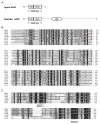Overproduction of lactimidomycin by cross-overexpression of genes encoding Streptomyces antibiotic regulatory proteins
- PMID: 26552797
- PMCID: PMC4758858
- DOI: 10.1007/s00253-015-7119-7
Overproduction of lactimidomycin by cross-overexpression of genes encoding Streptomyces antibiotic regulatory proteins
Abstract
The glutarimide-containing polyketides represent a fascinating class of natural products that exhibit a multitude of biological activities. We have recently cloned and sequenced the biosynthetic gene clusters for three members of the glutarimide-containing polyketides-iso-migrastatin (iso-MGS) from Streptomyces platensis NRRL 18993, lactimidomycin (LTM) from Streptomyces amphibiosporus ATCC 53964, and cycloheximide (CHX) from Streptomyces sp. YIM56141. Comparative analysis of the three clusters identified mgsA and chxA, from the mgs and chx gene clusters, respectively, that were predicted to encode the PimR-like Streptomyces antibiotic regulatory proteins (SARPs) but failed to reveal any regulatory gene from the ltm gene cluster. Overexpression of mgsA or chxA in S. platensis NRRL 18993, Streptomyces sp. YIM56141 or SB11024, and a recombinant strain of Streptomyces coelicolor M145 carrying the intact mgs gene cluster has no significant effect on iso-MGS or CHX production, suggesting that MgsA or ChxA regulation may not be rate-limiting for iso-MGS and CHX production in these producers. In contrast, overexpression of mgsA or chxA in S. amphibiosporus ATCC 53964 resulted in a significant increase in LTM production, with LTM titer reaching 106 mg/L, which is five-fold higher than that of the wild-type strain. These results support MgsA and ChxA as members of the SARP family of positive regulators for the iso-MGS and CHX biosynthetic machinery and demonstrate the feasibility to improve glutarimide-containing polyketide production in Streptomyces strains by exploiting common regulators.
Keywords: Antibiotic titer improvement; Biosynthesis; Glutarimide-containing polyketides; Regulation; Streptomyces antibiotic regulatory proteins.
Conflict of interest statement
Figures




References
-
- Bibb MJ. Regulation of secondary metabolism in Streptomycetes. Curr Opin Microbiol. 2005;8:208–215. - PubMed
-
- Bierman M, Logan R, O'Brien K, Seno ET, Rao RN, Schoner BE. Plasmid cloning vectors for the conjugal transfer of DNA from Escherichia coli to Streptomyces spp. Gene. 1992;116:43–49. - PubMed
-
- Bruheim P, Sletta H, Bibb MJ, White J, Levine DW. High-yield actinorhodin production in fed-batch culture by a Streptomyces lividans strain overexpressing the pathway-specific activator gene actII-ORF4. J Ind Microbiol Biotechnol. 2002;28:103–111. - PubMed
Publication types
MeSH terms
Substances
Grants and funding
LinkOut - more resources
Full Text Sources
Other Literature Sources
Medical

